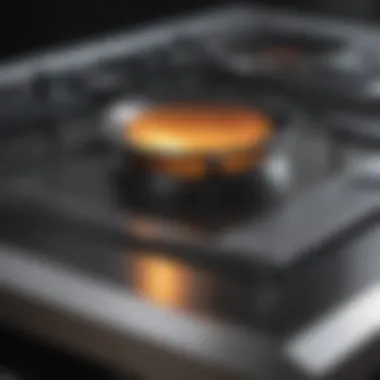Comprehensive Guide to Cleaning Stainless Steel Stoves


Intro
In the realm of kitchen maintenance, stainless steel stoves often capture the eye due to their sleek appearance and modern appeal. However, keeping these appliances looking fresh requires more than a mere wipe down. The unique properties of stainless steel necessitate specific cleaning techniques to ensure they remain functional and aesthetically pleasing.
Understanding how to care for these surfaces can significantly prolong their lifespan. In this guide, we will navigate through effective methods to clean stainless steel stoves, discuss the best tools and agents against tough stains, and emphasize practices for preserving their shine.
This article is essential for those who appreciate the fusion of design and utility in their culinary environments. We aim to equip you with valuable insights that will enhance both the beauty and functionality of your kitchen appliances.
Understanding Stainless Steel Appliances
Cleaning stainless steel appliances requires a good grasp of the materials themselves. Understanding why stainless steel is widely used in kitchens is crucial for effective maintenance and care.
Stainless steel is favored not just for its sleek appearance but also for its durability. It resists corrosion, staining, and rust, making it ideal for high-use areas such as kitchens. Knowing the properties of stainless steel can help you choose the right cleaning methods and products. For instance, it is important to be aware that stainless steel surfaces can scratch easily when abrasive materials are used. Thus, an informed approach is necessary.
Additionally, acknowledging common issues associated with stainless steel stoves can guide regular cleaning schedules. Problems such as fingerprints, smudges, or water spots can detract from the appliance’s appearance. A deeper dive into the properties and common issues will help one develop an effective cleaning routine. This foundational understanding is key to preserving the aesthetic appeal and functionality of your kitchen appliances.
Essential Cleaning Supplies
Cleaning stainless steel stoves effectively requires the right supplies. Having essential cleaning items at hand can greatly streamline the cleaning process and ensure that surfaces remain pristine. Each item serves a unique purpose and contributes to maintaining the stove's finish and functionality. By investing time in selecting these supplies, homeowners can enhance their appliance's longevity while promoting a clean cooking environment.
Recommended Cleaning Solutions
Commercial Cleaners
Commercial cleaners are widely available and favored for their efficiency. These products are specifically formulated for stainless steel and often contain agents that cut through grease and grime quickly. A notable characteristic of commercial cleaners is their strong cleaning power, which can leave the surface shiny and free from streaks. Many popular brands, such as Weiman and Bar Keepers Friend, are trusted choices among homeowners for effective cleaning.
However, while they are highly effective, these cleaners may sometimes contain harsh chemicals. This is an important consideration, especially for those with sensitivities or households with children. Users should always check the safety instructions before application to avoid any potential damage to the surface or health hazards.
Homemade Solutions
Homemade solutions can be a viable alternative to commercial cleaners. Simple mixtures like vinegar and water or baking soda and water are common choices. A key characteristic of homemade solutions is their non-toxic nature, making them a safer option for families and the environment. Many homeowners appreciate that these solutions can be made from everyday ingredients found at home.
One advantage of homemade cleaners is their cost-effectiveness; they can significantly reduce cleaning expenses. However, a unique feature is that they may not offer the same immediate results as commercial cleaners, particularly on tough stains. Care should be taken to test these solutions on a small area first to prevent any unwanted reactions with the stainless steel surface.
Tools for Effective Cleaning
Microfiber Cloths
Microfiber cloths are an essential tool for cleaning stainless steel. They are known for their fine fibers, which can trap dirt and dust without scratching the surface. A significant attribute of microfiber cloths is their ability to attract and hold moisture, making them ideal for cleaning and polishing. Many users find them beneficial because they can be washed and reused, providing an eco-friendly cleaning solution.
One downside to microfiber cloths is that they need to be maintained properly. Washing them with fabric softener can diminish their effectiveness, so it is important to wash them according to instructions.
Non-Abrasive Sponges
Non-abrasive sponges are specifically designed to clean surfaces gently. Their soft texture minimizes the risk of scratches on stainless steel, making them a safe choice for regular cleaning. Because they are available in various sizes and shapes, they can be used on different stove configurations.


One appeal of non-abrasive sponges is their versatility; they can be utilized with both commercial and homemade cleaning solutions. However, some users may find them less effective on tougher stains, requiring multiple applications.
Brushes
Brushes are handy for tackling difficult areas, such as around knobs or burners. Their stiff bristles can penetrate crevices where grime may accumulate. A distinct feature of brushes is their ability to reach spots that cloths and sponges might miss. They are particularly useful when paired with a suitable cleaner to enhance the cleaning process.
However, not all brushes are suitable for stainless steel. Using a brush with harsh bristles may lead to scratching and permanent damage. Hence, it is crucial to choose brushes specifically designed for this material to avoid any downside.
Step-by-Step Cleaning Process
Cleaning stainless steel stoves is an essential practice for maintaining their appearance and functionality. In this section, we detail a step-by-step process that simplifies your cleaning routine. A systematic approach helps achieve the best results, ensuring that every part of your stove receives the attention it needs. Following these steps not only enhances the look of your appliance but also prolongs its lifespan.
Initial Surface Preparation
Before applying any cleaning solution, preparing the surface of your stainless steel stove is vital. Start by removing any items from the stovetop. This includes cookware, utensils, and any decorative elements. Ensuring a clear workspace allows you to see all the areas needing cleaning. Next, wipe down the surface with a dry microfiber cloth to eliminate loose debris such as dust or crumbs. This step is crucial as it prevents scratching the metal during the subsequent cleaning process. Taking the time to prepare the surface effectively can lead to a more thorough clean.
Applying the Cleaning Solution
Choosing the right cleaning solution is pivotal for effective results. Based on your cleaner, follow the manufacturer’s instructions for dilution if necessary. Using a spray bottle can make application easier, allowing you to cover vast areas uniformly. If you prefer a homemade solution, a standard mix of equal parts vinegar and water is effective. After applying, let the solution sit for a few minutes. This helps to break down any stubborn stains or grime before scrubbing begins. Applying the solution carefully ensures that no area of the surface is overlooked, maximizing your cleaning efforts.
Scrubbing Techniques
When scrubbing, select a non-abrasive sponge or cloth to avoid damage to the stainless steel surface. Use a circular motion, applying moderate pressure while focusing on stained areas. For greasy spots or tough stains, consider using a dedicated cleaning brush. Make sure to rinse the sponge often to prevent re-depositing dirt back onto the surface. This technique helps to lift grime without scratching the finish. Pay special attention to the edges and corners, as these areas often trap dirt. Adopting proper scrubbing techniques can significantly enhance the overall cleanliness of your stove.
Rinsing and Drying
Rinsing is an essential step often overlooked. After scrubbing, use a clean, damp microfiber cloth to wipe away any residue from the cleaning solution. This prevents any streaks or dullness from forming on the stainless steel. It's advisable to rinse until the cloth is free of dirt and cleaner. Once rinsed, it's crucial to dry the stove thoroughly. For drying, use a second clean microfiber cloth. This step removes any remaining moisture, which can cause spots or water stains if left on the surface. An effective rinse-and-dry routine preserves the shine and luster of your stainless steel appliance.
Addressing Specific Stains and Marks
Cleaning stainless steel stoves requires understanding the distinct characteristics of the surface. Stainless steel is widely appreciated for its modern appeal, but it is prone to various stains and marks. Addressing these specific issues effectively not only maintains the aesthetic quality of the appliance but also prolongs its lifespan. Different stains may require targeted cleaning methods and products. Therefore, knowing how to treat them is essential for maintaining both the elegance and functionality of your kitchen.
Dealing with Fingerprints
Fingerprints are perhaps the most common nuisance on stainless steel surfaces. When touched, the natural oils from fingers leave marks that are difficult to ignore. The main issue with fingerprints is that they disrupt the sleek, polished look of stainless steel. To remove these marks, some people might first wipe the surface with a dry, microfiber cloth to minimize smudging. For persistent fingerprints, a mixture of warm water and a small amount of dish soap can be used. The cloth should be slightly dampened with the solution before wiping the affected area. After cleaning, a dry microfiber cloth can restore the shine, preventing streaking.
Removing Grease and Grime
Grease and grime accumulate from regular cooking activities. The build-up affects the functionality and aesthetics of the stove. For effective removal, a degreasing agent is usually necessary. A popular choice is a commercial stainless steel cleaner, but homemade solutions can also be effective. A mixture of vinegar and water can cut through grease if applied and allowed to sit for a moment before wiping. Using a non-abrasive sponge ensures that the surface remains scratch-free. For heavy grease deposits, a gentle scrubbing with a suitable brush might be required, but care must be taken to avoid damaging the metal.
Tackling Rust Spots
Rust spots can occur on stainless steel, although it's less common compared to other metals. This typically suggests that the protective layer has been compromised, often due to exposure to moisture or harsh chemicals. To treat rust spots, a paste can be made from baking soda and water. Applying this paste to the rusted area and letting it sit for a few minutes can help. Gently scrubbing with a non-abrasive sponge can then remove the rust. Once cleaned, ensure to dry the area thoroughly to prevent further rust development. Regular maintenance and prompt cleaning help in mitigating this issue effectively.
"A little preventive care goes a long way in maintaining the shine and quality of stainless steel."


In summary, addressing specific stains and marks on stainless steel stoves requires attention to detail and the right cleaning techniques. Identifying the type of stain is the first step in ensuring an effective cleaning process. Stick to gentle, yet effective methods to maintain the finish.
Maintaining Stainless Steel Stoves
Maintaining stainless steel stoves is pivotal for both functionality and aesthetics in the kitchen. Regular care not only keeps appliances visually appealing but also extends their lifespan. Stainless steel is known for its durability; however, neglect can lead to stains, rust, and scratches, undermining the material's inherent advantages. Therefore, establishing a consistent maintenance routine is essential to preserve the resplendent finish and performance of these appliances.
Regular Cleaning Schedule
A regular cleaning schedule should be an integral part of maintaining your stainless steel stove. This prevents grime and stains from becoming entrenched, making future cleaning easier and more effective. The frequency of cleaning can depend on usage. For high-traffic kitchens, cleaning after each use can be ideal, particularly for surfaces that are prone to splatters and spills.
For less frequently used appliances, a weekly wipe down might suffice. Consider implementing the following steps:
- Daily Wipe Down: After each use, simply wipe down the surface with a damp cloth. This quick task will remove food particles and moisture.
- Weekly Deep Cleaning: Once a week, use a suitable cleaner and microfiber cloth to clean the entire surface thoroughly. This is essential for preventing buildup.
- Monthly Check-Up: Inspect for any scratches or stains. Address any problems promptly to avoid escalation.
By adhering to a regular cleaning schedule, you can maintain the integrity of the stove’s surface and minimize the risks of more extensive damage over time.
Best Practices for Long-Lasting Finish
To achieve a long-lasting finish on your stainless steel stove, certain best practices should be followed. These methods not only enhance appearance but also protect the surface from unwanted wear. Here are some key suggestions:
- Use Non-Abrasive Cleaners: Always choose cleaners specifically designed for stainless steel or opt for mild, homemade solutions to avoid scratching the surface.
- Avoid Steel Wool and Scouring Pads: These materials can cause scratches that are difficult to repair. Instead, use soft sponges or microfiber cloths.
- Following the Grain: When cleaning, always wipe in the direction of the stainless steel grain. This method protects against visible scratches and maintains a uniform look.
- Dry Properly: After cleaning, ensure you dry the surface completely. Leaving moisture can lead to water spots and potential corrosion.
- Apply a Protective Layer: Occasionally applying a stainless steel cleaner or polish creates a barrier against fingerprints and smudges, keeping the surface cleaner for longer.
Regular maintenance and following these best practices ensures your stainless steel stove remains an attractive centerpiece in your kitchen, reflecting the quality of your culinary space.
By effectively implementing these strategies, homeowners can significantly enhance the durability and aesthetic of their stainless steel stoves. Effectively maintained appliances are not only visually appealing but also contribute to an overall efficient kitchen environment.
Safety Considerations
Cleaning stainless steel stoves is an essential task, but it comes with its own set of safety considerations. Understanding these aspects ensures that both your kitchen appliances and your health remain safeguarded during the cleaning process. Using the proper tools and methods not only extends the lifespan of the appliance but also reduces the risk of accidents or damage. Furthermore, being aware of what you are using on your appliances can prevent harmful chemical exposure.
Choosing Non-Toxic Cleaners
The prevalence of various cleaning agents can make it daunting to select the right one for your stainless steel stove. Non-toxic cleaners are beneficial in many ways. They are less likely to cause allergic reactions or pose health risks, particularly for household members with sensitivities. Non-toxic options can include items like vinegar, baking soda, and specific plant-based products that effectively clean without harsh chemicals.
- Benefits of Non-Toxic Cleaners:
- Safe for children and pets
- Environmentally friendly
- Minimized risk of chemical burns
When considering a cleaner, check the label for phrases like "biodegradable" or "eco-friendly". These indicators suggest that the product contains fewer harmful substances. Additionally, you might also consider homemade cleaning solutions. A mixture of water and vinegar, for instance, can be effective for routine cleaning tasks, proving both economical and safe.
Ensuring Appliance Safety Post-Cleaning
After cleaning your stainless steel stove, it is crucial to ensure its safety before normal use resumes. A few simple measures can help achieve this goal. First, make sure all cleaning agents are thoroughly rinsed and dried. This will prevent residue from affecting the stove's finish or even causing strange reactions if mixed with food.
- Post-Cleansing Safety Steps:


- Verify all surfaces are dry
- Keep cleaning agents out of reach
- Inspect for any lingering residues
Furthermore, checking for functionality is important after a deep clean. Make sure knobs, thermostats, and any other mechanical parts are responsive. This guarantees the appliance is ready for operation without any risk. If something seems off, consulting the manufacturer or a qualified technician might be prudent.
Important Note: Always read the user manual specific to your stove model for detailed instructions and cleaning recommendations.
Understanding Manufacturer Recommendations
Manufacturer recommendations are crucial for effective cleaning and maintenance of stainless steel stoves. They often provide specific guidance tailored to the individual appliance's design, materials, and finish. Ignoring these guidelines could lead to damage or diminish the appliance's aesthetic and functional qualities.
Following recommendations ensures that the cleaning techniques and products used are safe. Different manufacturers might have unique suggestions depending on the type of stainless steel used. Adhering to these guidelines not only helps maintain the stove's appearance but can also extend its lifespan.
Consulting User Manuals
User manuals contain vital information regarding the proper care of your stainless steel stove. They outline the dos and don’ts of cleaning, including recommended cleaning agents that are safe to use. These manuals may specify which types of abrasives or chemicals can harm the finish.
Additionally, user manuals often include instructions for removing and cleaning specific components, like burners and knobs. By consulting the manual, homeowners can avoid common pitfalls that might lead to scratches or discoloration.
"User manuals are an essential resource. They hold key insights that help maintain the integrity of your stainless steel appliance."
Warranty Considerations
Understanding warranty details is critical when maintaining your stainless steel stove. Many warranties stipulate that using non-recommended cleaning products can void the warranty. Homeowners must be mindful of this, as any damage caused by unauthorized cleaners may result in costly repairs without coverage.
It is advisable to review the warranty documentation to grasp clauses thoroughly. Keeping records of purchases and consistently using the recommended cleaning methods promotes peace of mind. This ensures compliance with warranty conditions while safeguarding the appliance.
Closure
The conclusion of this article is paramount as it synthesizes various aspects of caring for stainless steel stoves. It underscores the importance of not only cleaning but also maintaining the appliance to ensure its longevity and aesthetic appeal.
By summarizing the effective cleaning methods, recommended supplies, and specific strategies for addressing stains, the reader gains a holistic view. The insights provided here emphasize that regular maintenance can prevent grime buildup and preserve the appliance's shine, making it more functional every day.
Additionally, a well-kept stainless steel stove enhances the entire kitchen's appearance, which is significant for homeowners who value both form and function.
Furthermore, following the guidelines leads to better safety practices. Understanding how to safely clean these appliances and utilize the right products means fewer accidents in the kitchen. Ultimately, it is about fusing practicality with care, ensuring that the stove performs efficiently while remaining a centerpiece in home aesthetics.
Summarizing Key Points
In this article, we discussed several vital aspects:
- Properties of stainless steel that make it a preferred choice for stoves.
- Essential cleaning supplies, including both commercial and homemade solutions.
- Step-by-step cleaning process that ensures an effective and safe approach.
- Techniques to address specific stains, ensuring your stove looks its best.
- The significance of regular maintenance schedules.
These points serve as a guide to not just cleaning but instilling a habit that enhances both the functionality and longevity of your stainless steel stove.
Encouraging Consistent Care
Consistent care for stainless steel stoves is not just an option; it is a necessity. Establishing a regular cleaning routine will help to mitigate the effort needed during intensive cleanings. Here are some tips for ongoing care:
- Use microfiber cloths for daily wipe-downs; they prevent streaks.
- Avoid abrasive cleaners that can scratch the surface, preferring gentler solutions instead.
- Address spills or stains promptly to avoid them becoming permanent marks.
- Keep the stove area free from dust and grease accumulation by regularly checking and maintaining cleanliness.
By committing to these practices, homeowners can enjoy a well-maintained kitchen appliance that not only performs effectively but also acts as an attractive element within the home.







